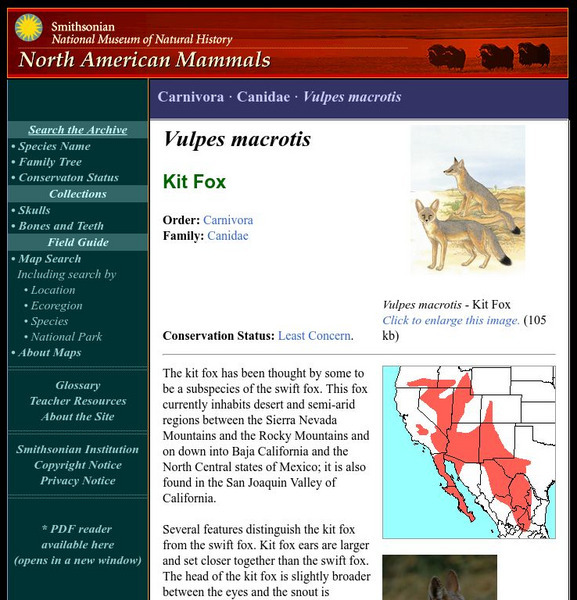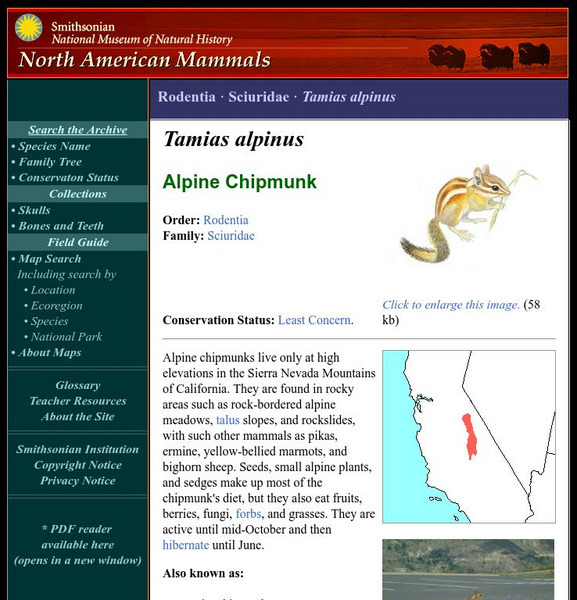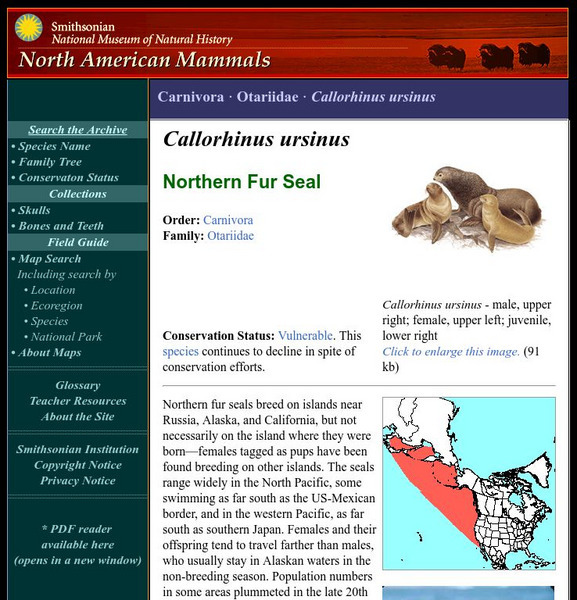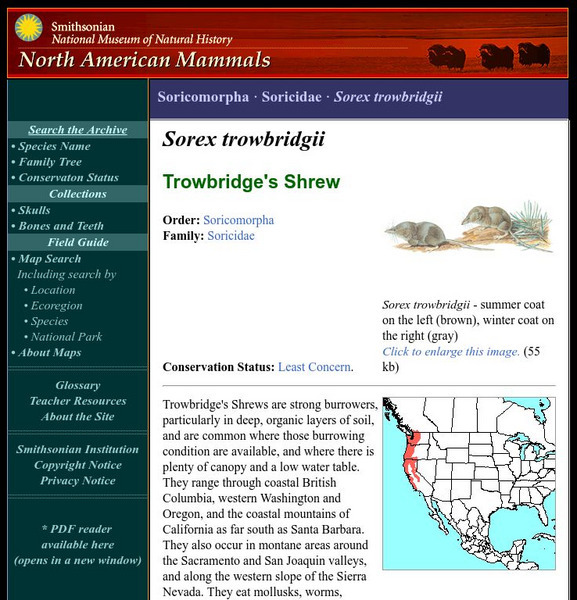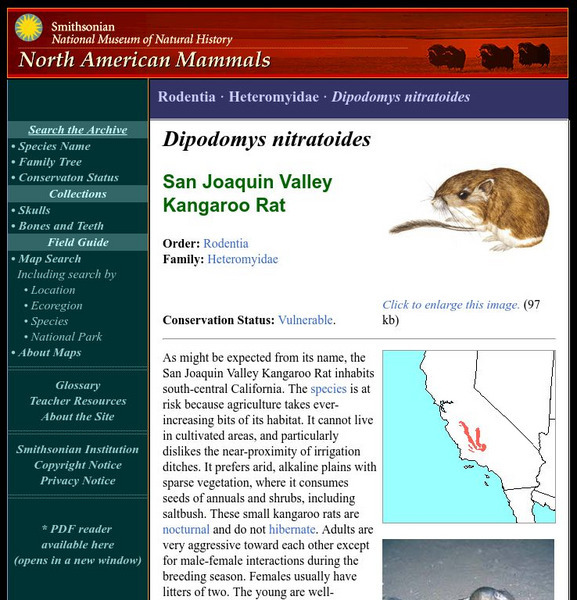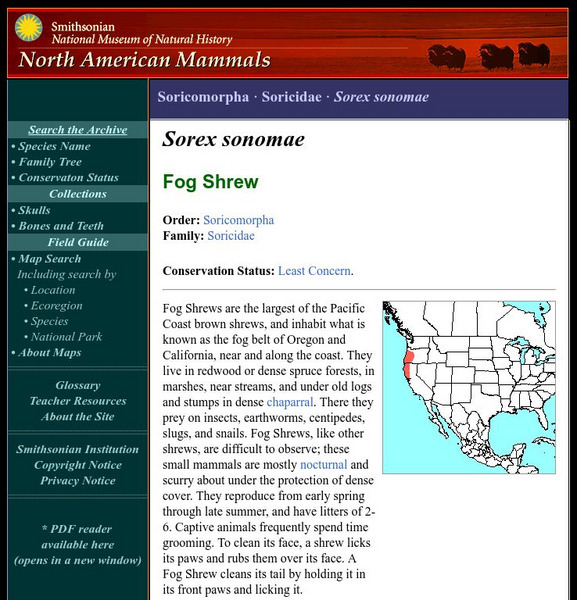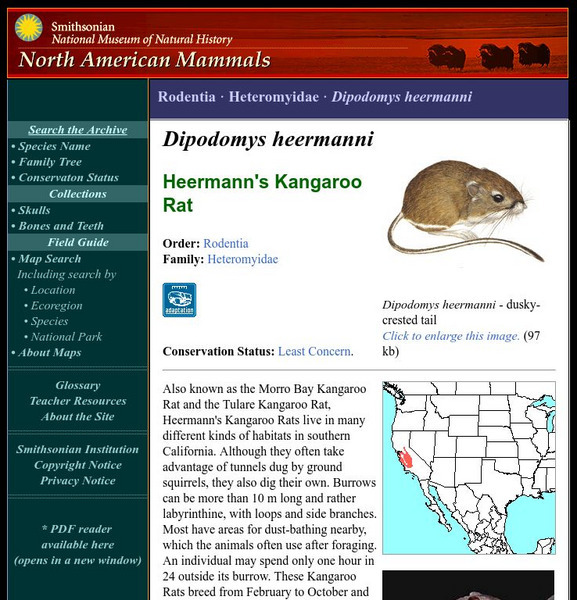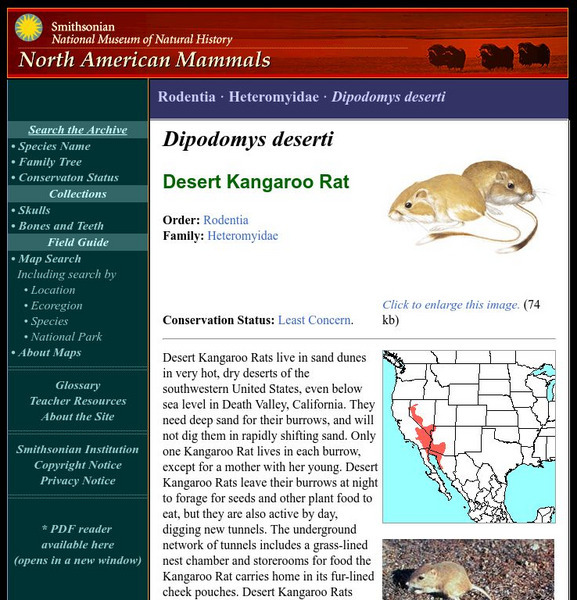Smithsonian Institution
National Museum of American History: Life in Japanese American Internment Camp
Information about life in an internment camp. Includes related activities and links to books and other websites on Japanese American internment.
University of California
Ucmp: Understanding Geologic Time
A slideshow for teachers and students exploring Earth's geologic timeline and history. Click the buttons at left to select the teacher or student version.
University of California
Ucmp: The Dinosauria
The Dinosauria provides the latest information about dinosaurs, including debunking myths, early dinosaur discoveries, characteristics of specific dinosaurs, life history, and discovery of dinosaur fossils.
Smithsonian Institution
National Museum of Natural History: American Mammals: San Diego Pocket Mouse
The San Diego Pocket Mouse occurs in desert and coastal habitats in southern California, Mexico, and northern Baja California, from sea level to at least 1,400 m. Yellowish or orange hair on its sides contrasts with a dark brown back,...
Smithsonian Institution
National Museum of Natural History: American Mammals: Kit Fox
The kit fox has been thought by some to be a subspecies of the swift fox. This fox currently inhabits desert and semi-arid regions between the Sierra Nevada Mountains and the Rocky Mountains and on down into Baja California and the North...
Smithsonian Institution
National Museum of Natural History: American Mammals: Big Eared Kangaroo Rat
The Big-eared Kangaroo Rat has the longest ears of any kangaroo rat, and weighing in at about 85 g, is one of the largest Dipodomys species in California. It is dark cinnamon in color, with white underparts and brown ears. Learn more...
Smithsonian Institution
National Museum of Natural History: American Mammals: Alpine Chipmunk
Alpine chipmunks live only at high elevations in the Sierra Nevada Mountains of California. They are found in rocky areas such as rock-bordered alpine meadows, talus slopes, and rockslides, with such other mammals as pikas, ermine,...
Smithsonian Institution
National Museum of Natural History: American Mammals: White Footed Vole
White-footed Voles inhabit a relatively small area of the Pacific coast of North America, from Humboldt Bay, California, north to the Columbia River. They have small eyes, and their claws are suitable for burrowing, so they probably have...
Smithsonian Institution
National Museum of Natural History: American Mammals: Pale Kangaroo Mouse
Most Pale Kangaroo Mice live in high, cold desert in Nevada; there is also a small population in eastern California. They look like small kangaroo rats, and like them, can hop on their large hind feet. Learn more about the Microdipodops...
Smithsonian Institution
National Museum of Natural History: American Mammals: White Eared Pocket Mouse
One subspecies of the White-eared Pocket Mouse may be extinct, and the other is extremely rare, consisting of isolated, relict populations near the western Mojave Desert in California. White-eared Pocket Mice are nocturnal and probably...
Smithsonian Institution
National Museum of Natural History: American Mammals: Townsend's Mole
The largest moles in North America, weighing in at 100 - 171 grams, Townsend's Moles live only in the lowlands on the western side of the Cascade Mountains, from northwestern California to extreme southwestern British Columbia. One...
Smithsonian Institution
National Museum of Natural History: American Mammals: Nelson's Antelope Squirrel
Open, rolling land and gentle slopes with shrubs are the habitat of Nelson's Antelope Squirrel, which lives only in a small region of California in and near the San Joaquin Valley. The squirrels live in relatively small colonies of six...
Smithsonian Institution
National Museum of Natural History: American Mammals: Northern Fur Seal
Northern fur seals breed on islands near Russia, Alaska, and California, but not necessarily on the island where they were born females tagged as pups have been found breeding on other islands. The seals range widely in the North...
Smithsonian Institution
National Museum of Natural History: American Mammals: Mt. Lyell Shrew
The Mt. Lyell Shrew occurs only in the central Sierra Nevada Mountains of California and is found only at elevations above 2,000 m. Learn more about the Sorex lyelli, more commonly known as a Mt. Lyell Shrew, in this easy-to-read species...
Smithsonian Institution
National Museum of Natural History: American Mammals: Trowbridge's Shrew
Trowbridge's Shrews are strong burrowers, particularly in deep, organic layers of soil, and are common where those burrowing condition are available, and where there is plenty of canopy and a low water table. They range through coastal...
Smithsonian Institution
National Museum of Natural History: American Mammals: Yellow Cheeked Chipmunk
Yellow-tailed chipmunks are common in California's dark, moist giant redwood forests. These relatively large chipmunks are hard to see but they can be recognized by a unique call given when intruders are present. Learn more about the...
Smithsonian Institution
National Museum of Natural History: American Mammals: Western Red Backed Vole
The Western Red-backed Vole lives in conifer forests from the Columbia River south through western Oregon to northern California. Its population densities are greatest in dense, dark forests where there is little or no understory. Learn...
Smithsonian Institution
National Museum of Natural History: American Mammals: Stephen's Kangaroo Rat
Stephen's Kangaroo Rat is endangered, chiefly due to habitat loss. It lives only in isolated populations in three counties of southern California. Learn more about the Dipodomys stephensi, more commonly known as a Stephen's Kangaroo Rat,...
Smithsonian Institution
National Museum of Natural History: American Mammals: Narrow Faced Kangaroo Rat
The Narrow-faced Kangaroo Rat, also known as the Santa Cruz Kangaroo Rat, occurs in central coastal California where annual rainfall is 75 cm and temperatures are moderate. It requires well-drained, deep soils and is often found on...
Smithsonian Institution
National Museum of Natural History: American Mammals: Fresno Kangaroo Rat
As might be expected from its name, the Fresno Kangaroo Rat inhabits south-central California. The species is at risk because agriculture takes ever-increasing bits of its habitat. Learn more about the Dipodomys nitratoides, more...
Smithsonian Institution
National Museum of Natural History: American Mammals: Fog Shrew
Fog Shrews are the largest of the Pacific Coast brown shrews, and inhabit what is known as the fog belt of Oregon and California, near and along the coast. They live in redwood or dense spruce forests, in marshes, near streams, and under...
Smithsonian Institution
National Museum of Natural History: American Mammals: Island Gray Fox
Island gray foxes are thought to have arrived on three of the six California Channel Islands they now inhabit some 16,000 years ago, either by swimming or by rafting on floating debris. Humans, who first colonized the islands about 6,000...
Smithsonian Institution
National Museum of Natural History: American Mammals: Heermann's Kangaroo Rat
Also known as the Morro Bay Kangaroo Rat and the Tulare Kangaroo Rat, Heermann's Kangaroo Rats live in many different kinds of habitats in southern California. Although they often take advantage of tunnels dug by ground squirrels, they...
Smithsonian Institution
National Museum of Natural History: American Mammals: Desert Kangaroo Rat
Desert Kangaroo Rats live in sand dunes in very hot, dry deserts of the southwestern United States, even below sea level in Death Valley, California. They need deep sand for their burrows, and will not dig them in rapidly shifting sand....
Other popular searches
- 4th Grade California History
- California History Missions
- California History Unit Plan
- Folktales California History
- California History in 1920s
- California History Ranchos
- California History Gold Rush
- California History 8.3.7
- California History Skit
- California History Lessons
- California History 837
- California History Ranch's




